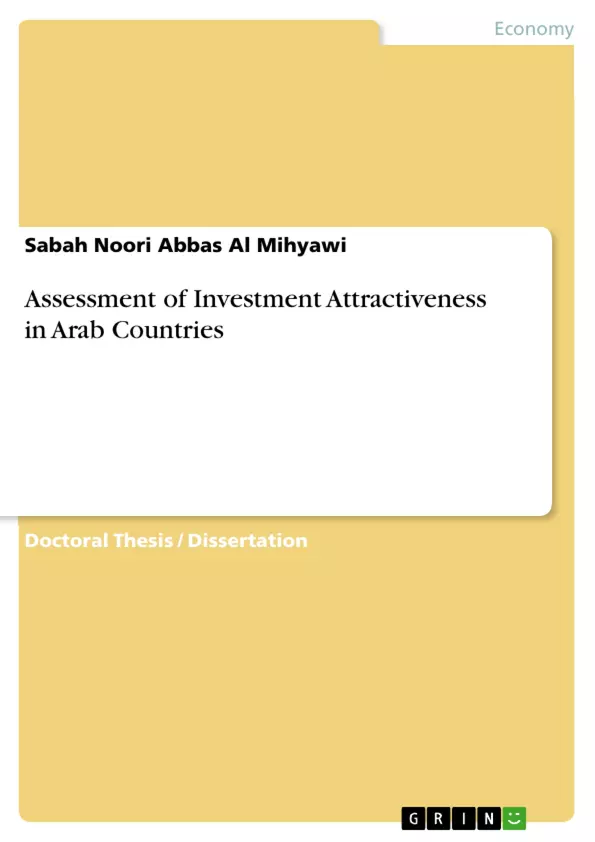The flow of investments in developing countries varies greatly across countries. In this research, due to the lack of capital markets in some of the Arab countries we have been focusing on foreign direct investment as one of types of foreign investment. Foreign investment comprises foreign direct investment (FDI), which inflows have provided the strong impetus on economic development across countries. FDI serves as an important source of supply of funds for domestic investments, promoting capital formation in the host country. Nowadays, more attention is paid to the issues of foreign direct investments at both national and international levels. According to World Investments reports, many developing countries, including the Arab countries, have attracted only small amounts of FDI inflows despite their efforts towards the economic openness.
It means many factors impede the flow of foreign capital to Arab countries. The attractiveness of investment is a set of features and factors that allow the investor to evaluate the potential of any country to be more attractive for investment than the other one. Many factors include economic factors, social factors and political factors, which lead to increase in foreign direct investment. The potential investor considers these factors when choosing a country for investments and evaluating investment attractiveness. The term of investment attractiveness refers to a set of factors that help to provide a suitable investment climate. The term of the investment climate means economic and financial conditions in a country that affect whether individuals and businesses are willing to do an investment there.
This climate is usually available through improving the determinants of investment. The problem of policy makers in the Arab countries is to identify the factors that determine the investment attractiveness and to know the factors, which have the greatest influence on it. In this study, we are trying to find out the most important factors having influence on investment in Arab countries. Attracting investment is an important component of competitiveness for any country. It is worth mentioning here that competitiveness means the set of institutions, policies and factors that determine the level of productivity of the country.
Inhaltsverzeichnis (Table of Contents)
- Introduction
- Literature Review
- Theoretical Framework
- Theories of Foreign Direct Investment
- Theories of International Investment and Development
- Empirical Evidence
- Investment Attractiveness and Factors Influencing Investment Decisions
- Determinants of Foreign Direct Investment in Developing Countries
- Investment Climate in Arab Countries
- Methodology
- Conceptual Framework
- Data and Sources
- Quantitative Data
- Qualitative Data
- Methods of Analysis
- Findings and Discussion
- Investment Attractiveness of Arab Countries
- Economic Factors
- Political Factors
- Social Factors
- Infrastructure Factors
- Human Capital Factors
- Investment Opportunities in Arab Countries
- Energy Sector
- Tourism Sector
- Information and Communications Technology Sector
- Agriculture Sector
- Manufacturing Sector
- Challenges and Recommendations for Investment in Arab Countries
Zielsetzung und Themenschwerpunkte (Objectives and Key Themes)
This dissertation aims to assess the investment attractiveness of Arab countries. It analyzes various factors influencing investment decisions, including economic, political, social, infrastructure, and human capital factors. It also explores investment opportunities and challenges faced by investors in the region. The primary objective is to provide a comprehensive overview of the investment landscape in Arab countries and to identify strategies for improving investment attractiveness.
- Factors influencing investment decisions in Arab countries
- Assessment of investment opportunities in key sectors
- Analysis of challenges and obstacles faced by investors
- Recommendations for enhancing investment attractiveness in the region
- The role of regional and global economic integration in attracting investment
Zusammenfassung der Kapitel (Chapter Summaries)
- Introduction: This chapter provides a background on the study, outlining its objectives, research questions, and the significance of the topic. It also highlights the key challenges and opportunities related to investment in Arab countries.
- Literature Review: This chapter examines existing literature on foreign direct investment, investment attractiveness, and development. It delves into various theoretical frameworks and empirical studies related to the topic, providing a comprehensive overview of the field.
- Methodology: This chapter outlines the research methodology used in the study. It describes the conceptual framework, data sources, and analytical methods employed to assess the investment attractiveness of Arab countries.
- Findings and Discussion: This chapter presents the main findings of the study, analyzing the various factors influencing investment decisions, including economic, political, social, infrastructure, and human capital factors. It also identifies investment opportunities in key sectors and examines the challenges faced by investors in the region.
Schlüsselwörter (Keywords)
The dissertation focuses on key topics such as foreign direct investment (FDI), investment attractiveness, Arab countries, economic development, political stability, infrastructure, human capital, investment opportunities, challenges, and recommendations. It utilizes a comprehensive framework to analyze the investment landscape in the region, drawing upon various theoretical perspectives and empirical evidence.
- Quote paper
- Sabah Noori Abbas Al Mihyawi (Author), 2016, Assessment of Investment Attractiveness in Arab Countries, Munich, GRIN Verlag, https://www.grin.com/document/387853



